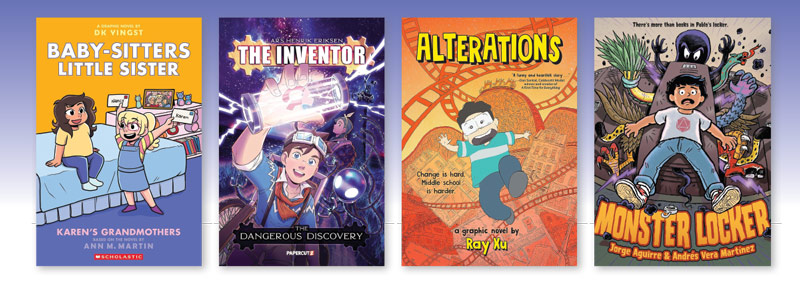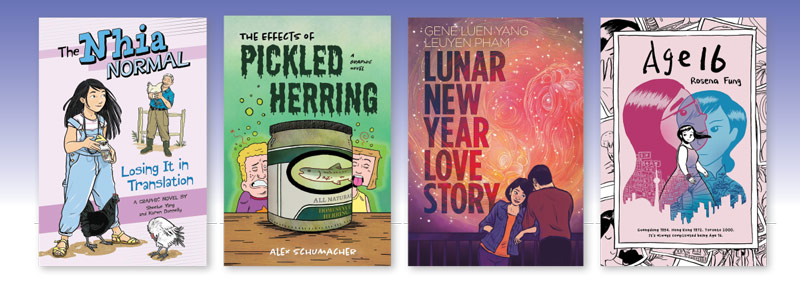Grandparents Play a Key Role in These Graphic Novels | Stellar Panels
In these stories, some grandparents are kind and loving, others carry the trauma of their past. Often, kids turn to them when they feel their parents won’t understand.
 In graphic novels, as in life, grandparents are complicated characters. Some are simply kind and loving; others carry the trauma of their past lives. Some come bearing unfamiliar foods, such as pickled herring, spicy chocolate, or preserved eggs, and novel interests like tai chi, poker, or classical music. In the best cases, they serve as an important third adult—someone whom children can turn to when they feel their parents won’t understand.
In graphic novels, as in life, grandparents are complicated characters. Some are simply kind and loving; others carry the trauma of their past lives. Some come bearing unfamiliar foods, such as pickled herring, spicy chocolate, or preserved eggs, and novel interests like tai chi, poker, or classical music. In the best cases, they serve as an important third adult—someone whom children can turn to when they feel their parents won’t understand.
In coming-of-age stories, grandparents often provide a safe space in turbulent times and help children see past their parents’ blind spots. And in stories of immigrant families, they bridge the old and new worlds in ways that can be uncomfortable, funny, illuminating, or all three, helping out in hard times and occasionally causing problems of their own.
It’s not all cookies, milk, and cuddles, though. In The Effects of Pickled Herring, 12-year-old Micah’s grandmother develops Alzheimer’s disease, and the story interweaves his family’s attempts to come to terms with that situation as he prepares for his bar mitzvah. In The Inventor, Cobalt’s inventor grandfather lets his enthusiasm get ahead of his common sense, and Cobalt suffers a terrible lab accident as a result. Even in the gentle Karen’s Grandmothers, Karen finds that she doesn’t like one of her grandmothers all that much.
Here’s a look at eight recent and upcoming stories where grandparents play a key role in young people’s lives.

MARTIN, Ann M. Baby-Sitters Little Sister: Karen’s Grandmothers. illus. by DK Yingst. Graphix. Oct. 2024.
Gr 2-5–As a child of divorced parents who both remarried, seven-year-old Karen has four grandmothers. When her school joins an Adopt-a-Grandparent program, she lights up at the idea of having a fifth—Grandma B. Her friend Nancy, though, is scared of old people. To help her, Karen asks one of her grandmothers to be Nancy’s pen pal. But Granny’s attention to Nancy leaves Karen feeling left out. Meanwhile, Karen grows weary of her own “adopted” grandmother. In the end, Nancy gets over her fear—and turns out to be a much better match with Grandma B than Karen. As with all the “Baby-Sitters Little Sister” books, the art is simple, with cute, rounded characters and uncluttered panels.
ERIKSEN, Lars Henrik. The Inventor Vol. 1: The Dangerous Discovery. illus. by author. Papercutz. Jan. 2024.
Gr 2-6–In this fantastical story, Cobalt Cogg lives with his mother on the island of Mata-Mata, where people ride giant turtles but also have electric toasters and hair dryers thanks to the ingenuity of Cobalt’s grandfather, Alfred, an inventor. Tragically, he’s an inventor so infatuated with his creations that he neglects the safety and comfort of others. When Cobalt and his friend Linnea sneak into the lab and cause a devastating accident that destroys Cobalt’s legs, Alfred is banished from the island. Cobalt’s injury is a dark moment, but Eriksen doesn’t dwell on it, skipping five years ahead to depict an older Cobalt testing out the robotic legs he built from a blueprint that Alfred left him. This sparks a new series of catastrophes, and the first volume ends with Cobalt leaving to search for Alfred in the hopes that he can set things right. The story has a clear message about the danger of becoming too enamored of technology and losing sight of its human cost. The art is colorful and filled with engaging details, including Alfred’s Rube Goldberg contraptions and the stuffed fishes and fish heads that are part of the decor in Cobalt’s house.
XU, Ray. Alterations. illus. by author. Union Square Kids. Jan. 2024.
Gr 3-7–Life has been tough for 10-year-old Kevin Lee and his family ever since his father left. Kevin’s mother works extra hours in her tailor shop to pay the bills, and he and his sister help out as well. Then his grandmother Popo arrives from China, bringing the scent of medicinal herbs, a repertoire of Chinese dishes, and plenty of tough love. Popo is plain-spoken and loves a good joke at her grandchildren’s expense, but she also shows Kevin another side of his overworked mother, who once tried to swim from China to Hong Kong. Cultures clash when Kevin brings a preserved egg to school for lunch and the smell clears out the cafeteria, earning him a nickname: Egg Boy. After that, it’s no coincidence that Kevin’s favorite comic character has the power to become invisible. The story is a mix of funny and poignant moments. Xu’s art is expressive and filled with details, and the supporting characters are all entertaining. If Kevin hasn’t exactly come of age by the end, he at least has earned a new nickname: Wonder-Boy.
AGUIRRE, Jorge. Monster Locker. illus. by Andrés Vera Martínez. First Second. Oct. 2024.
Gr 4-6–Aztec monsters invade a modern middle school in Columbus, OH, in this delightfully funny adventure. Pablo, the lead character, is hoping middle school will be a fresh start after the unfortunate bed-wetting incident that made him a pariah among his former friends. Instead, he has to contend with a genuinely haunted locker. He takes a matter-of-fact approach to the black blob of a monster that haunts it, until he accidentally opens up a portal and lets in the Aztec goddess Coatlicue. With his friends Maggie, a rebellious athlete, and Takashi, an anime-loving skateboarder, Pablo battles back the monsters Coatlicue unleashes and finally gives her what she wants: respect, with a quinceañera-like ceremony in which people offer earth-friendly acts as gifts. Pablo’s delightful grandmother also serves as an unreliable guide. The story is complex, with subplots and digressions, but it’s also fast-moving and funny. The art is simple but expressive, with deftly inked lines against backgrounds that appear to be painted with watercolors. Back matter includes information about Aztec gods and a glossary of the Nahuatl words in the text.

YANG, Sheelue. The Nhia Normal: Losing It in Translation. illus. by Karen Donnelly. Stone Arch. Aug. 2024.
Gr 4-6–“The Nhia Normal” is a series of middle-grade graphic novels about an 11-year-old Hmong American girl who has a lot of anxiety. In this one, the family visits her grandparents, whom they haven’t seen in some time. Nhia worries because she can’t speak Hmong. When they arrive, she is pleasantly surprised to learn that her grandmother has learned English, and although her grandfather has not, they manage to bond over the chickens and other farm animals. She’s also delighted by the familiar smells of her grandmother’s cooking and a video of her mother as a child. Donnelly’s fluid lines and subtle colors really bring this story to life, and Nhia and her family are delightful.
SCHUMACHER, Alex. The Effects of Pickled Herring. illus. by author. Mango. Mar. 2024.
Gr 4-8–The anxieties of adolescence are exacerbated for 12-year-old Micah when his grandmother develops Alzheimer’s disease. Micah and his sister are close in age—10 months apart—and they used to be close in other ways as well. But lately, all she seems to care about is diets and cheerleading. While their single mother struggles financially and the siblings are preparing for their b’nai mitvah, their grandparents provide warmth and love, taking them out for Saturday dinners and ice cream runs and caring for them when their mother works extra hours. The strain of his grandmother’s advancing Alzheimer’s adds to Micah’s anxiety, already running high as he worries about his bar mitzvah. In one dream sequence, he has a near-suicidal experience, hoping to be swallowed by a giant fish as Jonah was in the Bible. The book does a good job of explaining Alzheimer’s disease and showing its effects on family life. Micah’s grandfather has a part to play, too, offering support and a listening ear after a family argument. Schumacher lightens the story with cartoony art and plenty of humor, and ends with a touching moment: roles reverse, and Micah offers his grandmother the safe space she once provided him.
YANG, Gene Luen. Lunar New Year Love Story. illus. by LeUyen Pham. First Second. Jan. 2024.
Gr 6 Up–Valentina’s grandmother plays a supporting role in this charming YA love story, and she’s the catalyst that makes a lot of things happen. Valentina is a romantic who loves Valentine’s Day, conjuring up her own vision of a cupid to help her celebrate. But when she is 14, everything goes sideways: The Valentine’s Day cards she hands out earn her embarassment at school and an angry response from her father. Then her grandmother swoops in, sweeps Valentina off to church, and drops some earth-shattering news on her: Her mother is not dead, as she believed, and her father has been lying to her about it for years, in an attempt to spare her feelings. Two years later, Grandma comes to the rescue again, after the news that Valentina’s mother is getting married sends her father off on a bender. Again, Grandma’s intervention includes a trip to church, where Valentina meets a lion-dancing troupe and hits it off with one of the dancers. Unfortunately, Grandma also plants the idea in Valentina’s head that her family is unlucky in love, and Valentina worries that she won’t be able to shake that curse. Valentina is Vietnamese American, and her lion-dancing friends are Chinese and Korean, so the story, set in San Francisco, takes place in a mix of Asian cultures. Pham’s art is superb, depicting the multigenerational cast, the lion dancers, and the ghosts that haunt them with deft linework and allusions to Asian art.
FUNG, Rosena. Age 16. illus. by author. Annick. Jul. 2024.
Gr 10 Up–Rosalind’s grandmother is anything but warm and cuddly in this striking story that follows three generations of Chinese and Canadian women. At 16, living in Toronto in 2000, Rosalind is a teen who is self-conscious about her weight, and her mother’s comments don’t help. As prom approaches, she despairs about finding a dress that will fit, or a date. In 1972, Lydia, Rosalind’s mother, is 16 and living in Hong Kong, struggling not only with her weight but also with her cold and unloving mother, though buoyed by a supportive family friend. In 1954, Lydia’s mother, Mei Laan, is living in Guangdong, China, until her father announces that he has arranged a marriage for her to a wealthy man in Hong Kong—the 16-year-old’s ticket out of poverty. That dream goes sour when Mei Laan learns that she is the man’s second wife; she leaves him while already pregnant with Lydia. The story moves back and forth in time, showing how the elements of each woman’s life affect the others. Fung uses a different color for each time period, which allows her to carry pieces of the story forward. The art is flowing, expressive, and filled with details of the three locales. The story deals frankly with issues of body image and ends on a hopeful note, as Rosalind learns to accept herself and find friends who allow her to be comfortable in her own skin.
Brigid Alverson edits the blog “Good Comics for Kids.”

RELATED
The job outlook in 2030: Librarians will be in demand
The job outlook in 2030: Librarians will be in demand
ALREADY A SUBSCRIBER? LOG IN
We are currently offering this content for free. Sign up now to activate your personal profile, where you can save articles for future viewing






Add Comment :-
Be the first reader to comment.
Comment Policy:
Comment should not be empty !!!